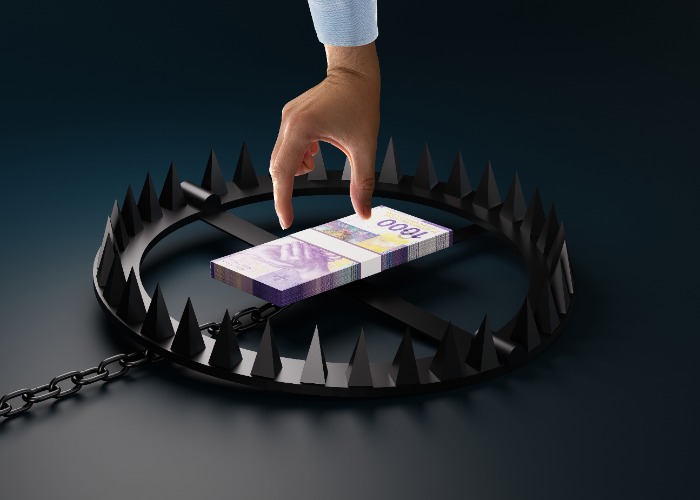Higher Rate taxpayers being caught by 'sneaky tax traps'

If your annual income exceeds £50,270, it's not just higher Income Tax you need to worry about.
More and more British workers are falling into the Higher Rate tax bracket due to wage inflation and the freezing of tax thresholds by successive Governments.
Official figures show that an extra 500,000 people will find themselves in the Higher Rate bracket in the current tax year alone, bringing the overall total to more than seven million by April 2026.
What's more, research has illustrated how becoming a Higher Rate taxpayer opens the floodgates to paying extra tax elsewhere in your finances.
Investment provider Hargreaves Lansdown has found that Higher Rate taxpayers lose out by paying more or losing out on benefits in other areas of their finances, such as Child Benefit and the Personal Allowance.
1. Personal Allowance squeeze
Anyone earning £100,000 sees their Personal Allowance – how much you can earn before incurring tax – reduced by £1 for every £2 that your adjusted net income is above this level, said Cole.
This means that once you earn £125,140, your Personal Allowance is wiped out entirely.
According to Sarah Coles, head of personal finance at Hargreaves Lansdown, this is an effective tax rate of 60%.
The threshold hasn’t changed since 2010 and, since then, wages have increased by more than 60%. If it had kept pace with inflation, it would now be £160,000.
2. Loss of Child Benefit
If you or your partner earn £60,000 or above and you claim Child Benefit, you will need to repay at least some of that money through your Self Assessment tax bill.
If one of you earns £80,000 you will have to repay it all.
However, if one of you isn’t working, it’s still worth claiming Child Benefit as it will enable you to qualify for National Insurance credits, which go towards your State Pension years.
Don’t cancel it – you can still claim Child Benefit but choose to waive the payments.
The charge was introduced in January 2013 at the threshold of £50,000 in earnings – and to keep up with the 53% increase in wages since then, it should have increased to £76,500.
3. Loss of tax-free childcare
Tax-free childcare from the Government is worth £2,000 a year but is only available to those earning less than £100,000.
The threshold was introduced in 2017 and wages have risen 40% since then.
4. The effect on savings and investments
Higher Rate taxpayers can only make £500 in interest on their savings before they incur tax on them – at the higher rate of 40%.
Those paying Basic Rate tax have a Personal Allowance of £1,000.
However, the personal savings allowance hasn’t been increased since it was introduced in April 2016.
Higher Rate taxpayers will also find themselves paying more tax on dividends. Basic Rate taxpayers pay tax on dividends at 8.75%, while higher rate taxpayers pay 33.75%.
The tax-free allowance has fallen from £5,000 in 2017/18 to £500 in the current tax year.
Meanwhile, Higher Rate taxpayers will also be liable for a higher rate of Capital Gains Tax on stocks and shares – this is now 18% for Basic Rate taxpayers and 24% for Higher Rate taxpayers.
The allowance on this has been cut to £3,000, having been as high as £12,300 in 2022/23.
How to cut your tax bill: use your pension
However, there are a number of ways you can reduce your tax bill, especially using your pension.
Pay into a pension to benefit from tax relief at a higher marginal rate.
You can pay up to £60,000 into your nest egg this tax year and make use of unused allowances from the previous three tax years.
Doing so could also mean you can reduce how much Child Benefit you could have to pay back if you’re a parent.
You can also use your pension payments to increase your personal tax allowance. If, for example, Cole explained, you earn £101,000 but pay £1,000 into a pension, you will get £400 tax relief.
However, it will also take your earnings under the threshold, saving you an additional £200 in tax.
You can also use this technique to retain your eligibility for tax-free childcare too.
Use your ISA allowance
Make the most of your ISA allowance to shield your savings from the taxman. You can pay up to £20,000 into an ISA this tax year.
A stocks and shares ISA is also a good way to shelter income-producing investments.
In addition, you can also take advantage of your Capital Gains allowance each year, using the share exchange or so-called ‘Bed and ISA’ process - selling investments held outside an ISA and re-buying them within an ISA.
You can also offset any capital losses you make during the tax year against gains.
Shift assets to your partner
Don’t forget to make use of your partner’s tax status if you are married or in a civil partnership and they pay a lower rate of tax.
Consider moving income-producing assets into their name to shelter them from tax or into their ISAs or pensions.
Lastly, Cole suggested that using a Venture Capital Trust could be an option, as it could get you up to 30% income tax relief on your investments.
However, it is a higher risk solution, so may not be suitable for everyone.
Comments
Be the first to comment
Do you want to comment on this article? You need to be signed in for this feature